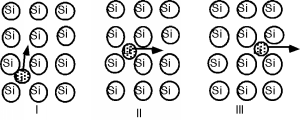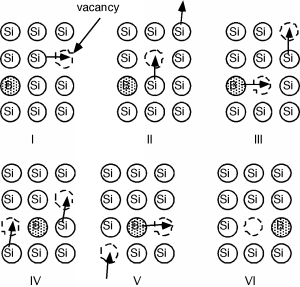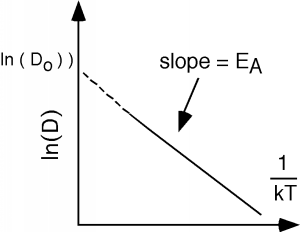4.4: Fick's First Law
- Page ID
- 88548
We talked about diffusion in the context of diodes, and described Fick's First Law of Diffusion for some particle concentration \(N(x, \ t)\): \[\text{Flux} = (-D) \frac{\text{d} N(x, t)}{\text{d} x} \quad\quad \text{Fick's First Law of Diffusion}\] \(D\) is the diffusion coefficient and has units of \(\mathrm{cm} / \mathrm{sec}\).
In a semiconductor, impurities move about either interstitially, which means they travel around in-between the lattice sites (Figure \(\PageIndex{1}\)), or they move by substitutional diffusion, which means they hop from lattice site to lattice site (Figure \(\PageIndex{2}\)). Substitutional diffusion is only possible if the lattice has a number of vacancies, or empty lattice sites, scattered throughout the crystal, so that there are places into which the impurity can move. Moving interstitially requires energy to get over the potential barrier of the regions between the lattice sites. Energy is required to form the vacancies for substitutional diffusion. Thus, for either form of diffusion, the diffusion coefficient \(D\), is a strong function of temperature.


To a very good degree of accuracy, one can describe the temperature dependence of the diffusion coefficient with an activation energy \(E_{A}\) such that: \[D(T) = D_{o} e^{- \frac{E_{a}}{kT}}\]
The activation energy \(E_{A}\) and coefficient \(D_{o}\) are obtained from a plot of the natural log of \(D\) vs. \(\dfrac{1}{kT}\), called an Arrhenius plot (Figure \(\PageIndex{3}\)). The slope gives \(E_{A}\) and the projection to infinite \(T\) \(\left( \frac{1}{T} \rightarrow 0\right)\) gives \(\ln \left(D_{o}\right)\).

The continuity equation holds for motion of impurities just like it does for anything else, so the divergence of the flux, \(\text{div } (F)\), must equal the negative of the time rate of change of the concentration of the impurities, or, in one dimension: \[\frac{\text{d}}{\text{d} x} (\text{Flux}) = - \frac{\text{d} N(x, t)}{\text{d} x}\]


